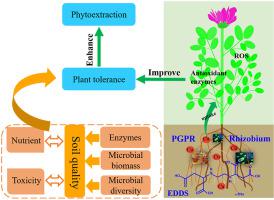当前位置:
X-MOL 学术
›
Chemosphere
›
论文详情
Our official English website, www.x-mol.net, welcomes your feedback! (Note: you will need to create a separate account there.)
Co-inoculation effect of plant-growth-promoting rhizobacteria and rhizobium on EDDS assisted phytoremediation of Cu contaminated soils.
Chemosphere ( IF 8.8 ) Pub Date : 2020-04-08 , DOI: 10.1016/j.chemosphere.2020.126724 Wenliang Ju 1 , Lei Liu 2 , Xiaolian Jin 3 , Chengjiao Duan 4 , Yongxing Cui 4 , Jie Wang 3 , Dengke Ma 4 , Wei Zhao 3 , Yunqiang Wang 5 , Linchuan Fang 6
Chemosphere ( IF 8.8 ) Pub Date : 2020-04-08 , DOI: 10.1016/j.chemosphere.2020.126724 Wenliang Ju 1 , Lei Liu 2 , Xiaolian Jin 3 , Chengjiao Duan 4 , Yongxing Cui 4 , Jie Wang 3 , Dengke Ma 4 , Wei Zhao 3 , Yunqiang Wang 5 , Linchuan Fang 6
Affiliation

|
Chelants application can increase the bioavailability of metals, subsequently limiting plant growth and reducing the efficiency of phytoremediation. Plant growth-promoting rhizobacteria (PGPRs) and rhizobium have substantial potential to improve plant growth and plant tolerance to metal stress. We evaluated the effects of co-inoculation with a PGPR strain (Paenibacillus mucilaginosus) and a Cu-resistant rhizobium strain (Sinorhizobium meliloti) on the efficiency of biodegradable chelant (S,S-ethylenediaminedisuccinic acid; EDDS) assisted phytoremediation of a Cu contaminated soil using alfalfa. The highest total Cu extraction by alfalfa was observed in the EDDS-treated soil upon co-inoculation with the PGPR and rhizobium strains, which was 1.2 times higher than that without co-inoculation. Partial least squares path modeling identified plant oxidative damage and soil microbial biomass as the key variables influencing Cu uptake by alfalfa roots. Co-inoculation significantly reduced the oxidative damage to alfalfa by mitigating the accumulation of malondialdehyde and reactive oxygen species, and improving the antioxidation capacity of the plant in the presence of EDDS. EDDS application decreased microbial diversity in the rhizosphere, whereas co-inoculation increased microbial biomass carbon and nitrogen, and microbial community diversity. Increased relative abundances of Actinobacteria and Bacillus and the presence of Firmicutes taxa as potential biomarkers demonstrated that co-inoculation increased soil nutrient content, and improved plant growth. Co-inoculation with PGPR and rhizobium can be useful for altering plant-soil biochemical responses during EDDS-enhanced phytoremediation to alleviate phytotoxicity of heavy metals and improve soil biochemical activities. This study provides an effective strategy for improving phytoremediation efficiency and soil quality during chelant assisted phytoremediation of metal-contaminated soils.
中文翻译:

促进植物生长的根瘤菌和根瘤菌对EDDS辅助接种铜污染土壤的植物修复作用。
施用螯合剂会增加金属的生物利用度,从而限制植物的生长并降低植物修复的效率。促进植物生长的根际细菌(PGPR)和根瘤菌具有极大的潜力,可以改善植物的生长和植物对金属胁迫的耐受性。我们评估了与PGPR菌株(Paenibacillus mucilaginosus)和耐铜的根瘤菌菌株(Sinorhizobium meliloti)共同接种对可生物降解的螯合剂(S,S-乙二胺二琥珀酸; EDDS)辅助铜污染土壤的植物修复的效率使用苜蓿。在与PGPR和根瘤菌菌株共同接种后,在经EDDS处理的土壤中,苜蓿的总Cu提取量最高,是未联合接种时的1.2倍。偏最小二乘路径模型确定了植物的氧化损伤和土壤微生物量是苜蓿根系吸收铜的关键变量。共接种可减轻丙二醛和活性氧的积累,并在存在EDDS的情况下提高植物的抗氧化能力,从而大大减少了对苜蓿的氧化损伤。EDDS的施用减少了根际微生物的多样性,而共接种则增加了微生物的生物量碳和氮以及微生物群落的多样性。放线菌和芽孢杆菌相对丰度的增加以及作为潜在生物标志物的沙门菌分类单元的存在表明,共同接种可增加土壤养分含量,并改善植物生长。与PGPR和根瘤菌的共接种可用于在EDDS增强的植物修复过程中改变植物土壤的生化反应,从而减轻重金属的植物毒性并改善土壤的生化活性。本研究为螯合剂辅助金属污染土壤的植物修复过程中提高植物修复效率和土壤质量提供了有效的策略。
更新日期:2020-04-20
中文翻译:

促进植物生长的根瘤菌和根瘤菌对EDDS辅助接种铜污染土壤的植物修复作用。
施用螯合剂会增加金属的生物利用度,从而限制植物的生长并降低植物修复的效率。促进植物生长的根际细菌(PGPR)和根瘤菌具有极大的潜力,可以改善植物的生长和植物对金属胁迫的耐受性。我们评估了与PGPR菌株(Paenibacillus mucilaginosus)和耐铜的根瘤菌菌株(Sinorhizobium meliloti)共同接种对可生物降解的螯合剂(S,S-乙二胺二琥珀酸; EDDS)辅助铜污染土壤的植物修复的效率使用苜蓿。在与PGPR和根瘤菌菌株共同接种后,在经EDDS处理的土壤中,苜蓿的总Cu提取量最高,是未联合接种时的1.2倍。偏最小二乘路径模型确定了植物的氧化损伤和土壤微生物量是苜蓿根系吸收铜的关键变量。共接种可减轻丙二醛和活性氧的积累,并在存在EDDS的情况下提高植物的抗氧化能力,从而大大减少了对苜蓿的氧化损伤。EDDS的施用减少了根际微生物的多样性,而共接种则增加了微生物的生物量碳和氮以及微生物群落的多样性。放线菌和芽孢杆菌相对丰度的增加以及作为潜在生物标志物的沙门菌分类单元的存在表明,共同接种可增加土壤养分含量,并改善植物生长。与PGPR和根瘤菌的共接种可用于在EDDS增强的植物修复过程中改变植物土壤的生化反应,从而减轻重金属的植物毒性并改善土壤的生化活性。本研究为螯合剂辅助金属污染土壤的植物修复过程中提高植物修复效率和土壤质量提供了有效的策略。

























 京公网安备 11010802027423号
京公网安备 11010802027423号